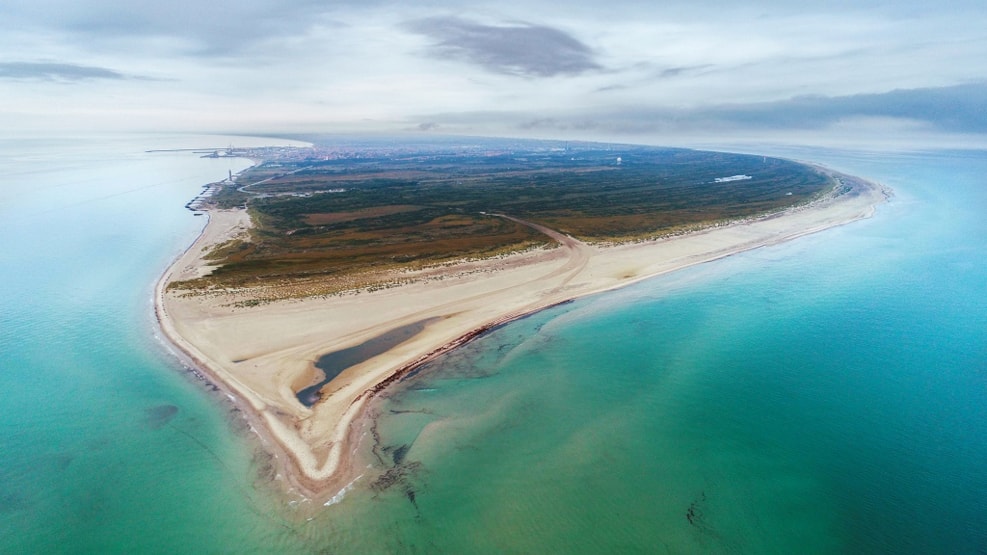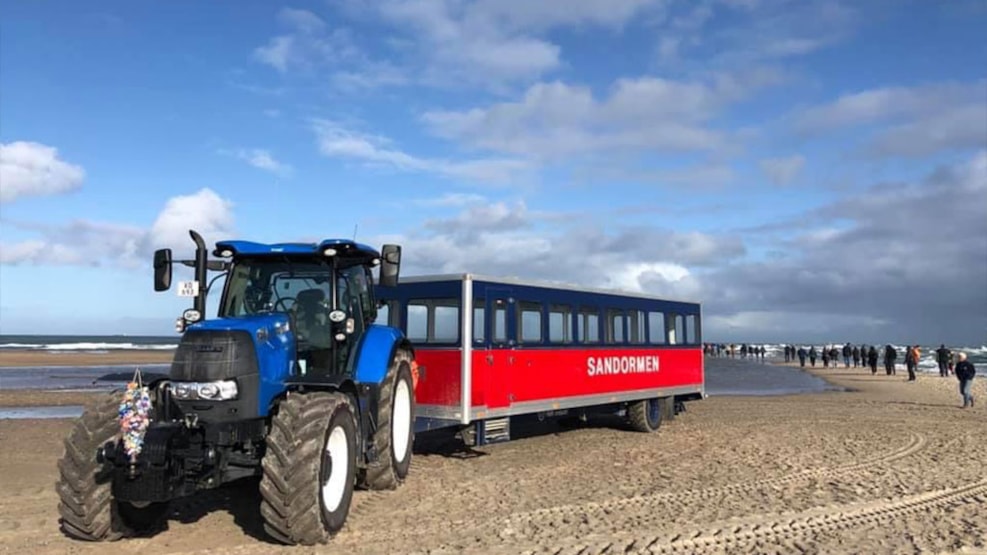At the very top of Denmark, where the land narrows into a sandy fingertip pointing toward Norway, lies Skagen. A windswept, sun-drenched gem. This location has long captivated artists, travelers, and nature lovers alike. Specifically, at Grenen, a rare natural wonder unfolds: the North Sea (Skagerrak) and the Baltic Sea (Kattegat) meet in a dramatic dance of opposing currents. Visitors can literally stand with one foot in each sea! A bucket-list experience that perfectly captures Skagen’s unique geography and magic.

Table of Contents
- Where the Seas Collide
- A Town That Inspired Generations of Artists
- The Light and Lifestyle
- Things to See and Do
- Where to Eat in Skagen
- Where to Stay in Skagen
- Best Time to Visit Skagen
- Getting There
- A Place Where Nature, Art, and Sea Collide
Where the Seas Collide
Grenen, the tapering spit of sand just a few kilometers north of Skagen town, presents a place of raw beauty. The clash of seas visibly creates a line of waves pushing against each other. An ever-changing, mesmerizing sight. Furthermore, the area acts as a haven for migratory birds and seals, thus making it ideal for nature photography and peaceful walks. For visitors who find the winds (and distances) too challenging on foot, a tractor-bus known as “Sandormen” takes them directly to the tip.
A Town That Inspired Generations of Artists
Skagen is not just about nature; it is also deeply woven into Denmark’s artistic and cultural heritage. In the late 19th century, a group of Scandinavian painters, known as the Skagen Painters, settled here. The ethereal light reflecting off the sea and sand truly enchanted them. Consequently, their works capturing fishermen, sunsets, and everyday coastal life are still admired at the Skagens Museum, which remains a must-visit for art lovers.
The Light and Lifestyle
The town itself is postcard-perfect. You see low yellow houses with red-tiled roofs, cobbled lanes, and flower-lined courtyards. A timeless, easygoing rhythm defines Skagen life: think morning walks along the beach, lazy lunches with freshly caught fish, and sunset dinners overlooking the dunes. Definitely do not miss the famous Skagen Fiskerestaurant at the harbor. Here, you can enjoy seafood platters and local white wine with the sea breeze in your hair. Indeed, the harbor area is lively in summer, filling with music, art stalls, and locals enjoying a glass of rosé in the golden evening light.

Things to See and Do
Beyond Grenen and the museum, Skagen offers plenty to explore. Specifically, you can find:
- Råbjerg Mile – This is one of Europe’s largest migrating sand dunes, offering a surreal mini-desert experience in northern Denmark.
- Den Tilsandede Kirke (The Buried Church) – Here are the haunting remains of a 14th-century church nearly swallowed by drifting sand.
- Skagen’s Beaches – These are perfect for long walks, shell hunting, or a chilly dip in the summer months.
- Anchers Hus and Drachmanns Hus – These preserved homes belonged to Skagen’s most famous artists.
- Skagen Lighthouse – Climb to the top of this structure for sweeping views over both seas.
Where to Eat in Skagen
Skagen’s food scene built itself around fresh seafood, Danish coastal tradition, and simple seasonal flavors. Here are a few favorites:
- Skagen Fiskerestaurant – This iconic harbor restaurant serves local fish and shellfish.
- Jakobs Café & Bar – You can find a relaxed spot here for smørrebrød, salads, and cocktails.
- Ruths Gourmet – This fine dining spot, part of the historic Ruths Hotel, focuses on Nordic ingredients.
- Pakhuset – This spot is great for steak, seafood, and live music right on the marina.
- Café & Restaurant Kokkenes – This cozy, local favorite offers traditional Danish comfort food.
Where to Stay in Skagen
Whether you want seaside luxury or a charming guesthouse, Skagen truly has something for every traveler:
- Ruths Hotel – The most famous stay in Skagen offers elegant rooms, spa facilities, and gourmet dining.
- Color Hotel Skagen – This comfortable, modern option features a pool and easy access to Grenen.
- Hotel Petit – A cozy, centrally located hotel makes exploring the town on foot easy.
- Skagen Harbour Hotel – This stylish boutique stay overlooks the marina.
- Skagen Strand Holiday Center – Families find this spot ideal, as it offers cottages, pools, and biking paths.
Best Time to Visit Skagen
Skagen changes beautifully with the seasons. Therefore, the best time to visit depends entirely on your preferences:
- Summer (June–August) – Long, sunny days and mild temperatures around 20–25°C mark this season. This is perfect for beach walks, outdoor dining, and the lively Skagen Festival, Denmark’s oldest music festival held in early July.
- Spring (April–May) – Blooming dunes and fewer tourists define the spring. This is a peaceful time to explore Grenen and cycle the coast.
- Autumn (September–October) – Crisp air, golden light, and migrating birds make this season a photographer’s dream.
- Winter (November–March) – The atmosphere is quiet and cozy, with roaring fireplaces and a glimpse of the North Sea at its wildest.
If you truly want the classic Skagen experience, aim for late June to early August. This is when the light is at its softest, the town feels full of energy, and the days seem to stretch forever.
Getting There
Skagen requires about a 5-hour train or car journey from Copenhagen. Alternatively, it is a 1-hour train ride from Aalborg. Once you arrive, everything falls within easy biking distance. Consequently, renting a bicycle is the best way to soak in the scenery at your own pace.
A Place Where Nature, Art, and Sea Collide
Skagen is not about ticking off attractions. Instead, it’s about slowing down, breathing in the salt air, and witnessing the meeting of worlds, both natural and cultural. Whether you come for the light, the landscape, or the sense of peaceful isolation, Skagen is the kind of place that stays with you long after the seas have met beneath your feet.
credit: enjoynordjylland.com
